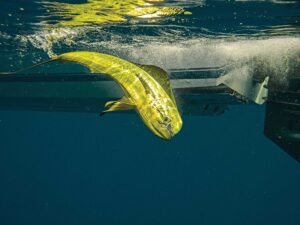In the 1930s, Bimini was home to the pioneers of big-game fishing. Legends like Zane Grey, Ernest Hemingway and Michael Lerner learned their craft on marlin and tuna in the Gulf Stream, little more than a mile offshore the island. Their exploits were heralded in the newspapers and magazines of the era, and continue to lure anglers to experience the excellent fishing and the ambience of this magical place that inspired many of Hemingway’s later writing.
Bimini, a cluster of three small islands, lies just 57 miles from Miami. The islands’ proximity, beautiful blue waters, abundant sea life and folklore continue to attract anglers and adventure-seekers who want to learn its history, traditions and reliable offshore fishing.
Bimini has plenty to offer with seasonal migrations of blue and white marlin, sailfish, wahoo, dolphin, and yellowfin, blackfin and bluefin tunas. Bluewater fishing is at its best from March through early July, and an amazing wahoo run extends from November through March. Bonefish prowl the flats between the islands year-round. They have produced numerous line- and tippet-class world records, including the all-tackle record of 16 pounds. Bimini is also responsible for the only “grander”—a 1,000-pound blue marlin—ever recorded in The Bahamas.
Most visitors come to Bimini on private boats or on the Bimini Fast Ferry that departs Fort Lauderdale, Florida, daily. When entering the cut between North and South Bimini, fishing boats head to the marinas at the legendary Bimini Big Game Club or the luxurious Hilton Resort World. Once there, be prepared to enjoy a stroll down memory lane, also known as Queens Highway.
Starting at its southern terminus in Alice Town, Queens Highway is the main road on North Bimini. Walking northward, you can stop along the way for the famous cracked conch and ice-cold Kalik beer at Joe’s Conch Stand, along with Bimini bread, a delicious staple throughout the islands, of which many loaves find their way back to the States. Your walk brings you past the site of the historic Complete Angler, which stood from 1935 until it was lost to fire in 2006. Hemingway was a frequent quest there during his time on the island. A little farther up the road, the prestigious Bimini Big Game Club, the epicenter of fishing activity on the islands today, features a marina, restaurant and bar, hotel, dive shop and liquor store. It also hosts charters for bonefish or offshore action for marlin, wahoo, dolphin and yellowfins.
Great Isaac Cay to the north is home to a historic 150-foot lighthouse built in London in 1852 and transported to the tiny cay in 1859. The abandoned island, with buildings roofless from hurricanes, now hosts an automated light that guides boats away from the rocky reefs of the Northwest Providence Channel. Expect to catch amberjack and grouper in those very reefs and rocks. To the south, the chain of cays bordering the western edge of the Great Bahama Bank includes Turtle and Piquet rocks, and Holm, Gun, North Cat, South Cat and Ocean cays. All offer fish-attracting structure for bottomfish, midwater structure for wahoo, and a drop into the depths of the Gulf Stream.
Other places to see include the Healing Hole, a pond of mineral-rich fresh water surrounded by salt water, which offers fabled healing powers and dates back hundreds of years to when the Lucayan Indians roamed the islands. The Bimini Biological Field Station and Shark Lab in Port Royale on South Bimini provides tours and instructional talks on the island’s marine life, and some of the most beautiful soft-sand beaches in The Bahamas run up the western shoreline.
Bimini, with its special place in sport-fishing history, continues the legacy, providing anglers with stories of their own today.
Click here to learn more about Bimini!









